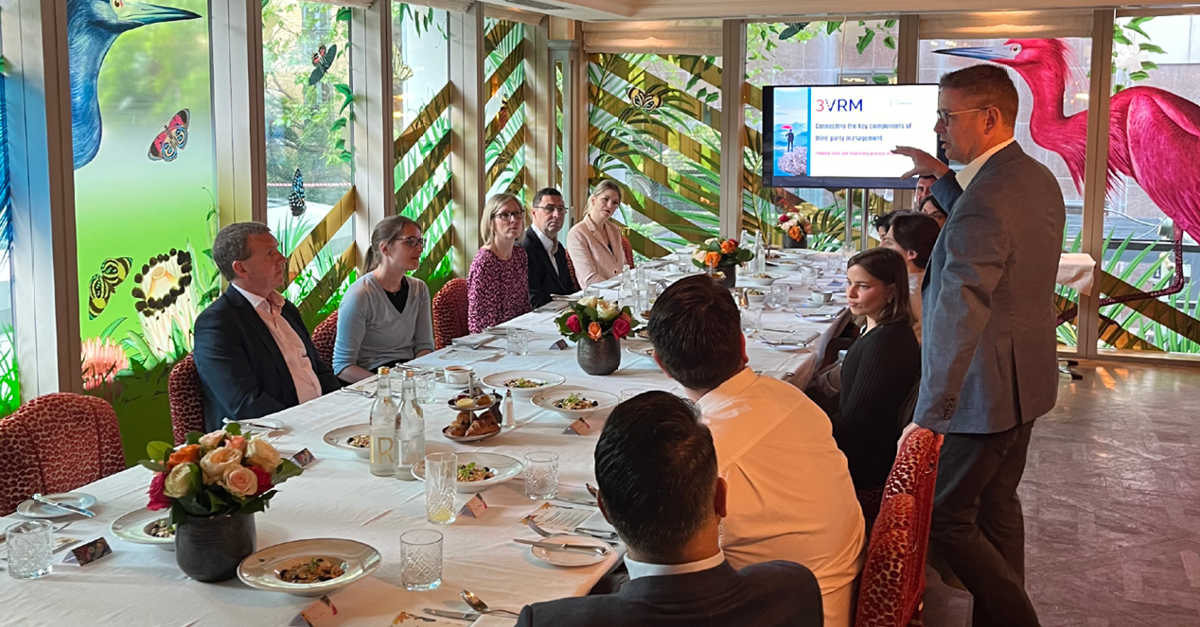
Connecting the key components of third-party management: a procurement roundtable breakfast
Investigo’s procurement team and 3VRM hosted a breakfast roundtable event at The Ivy City Garden on Wednesday 15th May, on connecting the key components of third-party management. Jayne Hughes, Jake Preece and Lewis Douglas from Investigo were joined by Daniel Crease, Luke Parkinson, Ash Patel and Charlotte Atkins from 3VRM to discuss how to topple silos and improve process efficiency. Here are the key takeaways from the discussion.
Risk needs to be collectively owned across the organisation
Every organisation is at a different level of maturity with its risk function, experiencing its own individual challenges and successes. But there’s one question that’s equally relevant for every organisation: ‘Who owns the risk?’ The answer very much depends on the organisation. Risk sits within different functions in different businesses, suggesting that it’s not about an individual risk, but about business continuity. If we’re to understand and manage it effectively, risk needs to be shared across the business in a unified way.
Third-party risk vs third-party resilience
There was a feeling that the concept of risk has negative connotations. By its nature, the word implies something to be feared and avoided, encouraging a mindset of caution. Perhaps it’s time to reframe how stakeholders perceive third-party risk management (TPRM) functions by replacing risk with resilience. By shifting the cultural perception of risk functions and managers, perhaps we can create a more proactive mindset in approaching our challenges, viewing them as something to face and overcome rather than something to be avoided.
Whatever you call your risk function, we can’t lose sight of the experience for users of our TPRM process. TPR teams all start somewhere – usually on a spreadsheet. One of the clients present discussed how their organisation shifted to an automated process through regular consultation, working closely with stakeholders to make the process more robust. Part of that has been educating senior managers and contract managers on risk and embedding it into the process.
The future for procurement and TPR
Managing and combating risk on a global scale has become more difficult than ever due to the many challenges that come with a global remit. Procurement and supply chain risks include compliance, quality, fraud, cost and delivery – risks which have become increasingly prominent against a backdrop of geopolitical instability where countries have sanctions imposed against them.
The challenges facing TPRM teams are constantly changing with the emergence of new areas such as ESG and AI. ESG information is increasingly in demand as we move to a mandatory environment of reporting under new requirements from the International Sustainability Standards Board (ISSB), the European Financial Reporting Advisory Group (EFRAG), and the US Securities and Exchange Commission (SEC), not to mention recommendations from the Taskforce on Nature-related Financial Disclosures (TNFD). We could see more organisations bring in an ESG controller or a team dedicated to ESG reporting, supported by non-financial risk reporting software, as they look to more effectively monitor non-financial risk.
At the same time, AI is reshaping workforces and business models, as well as introducing a whole new strand of risk to organisations in the form of AI-powered cyber attacks and the rise of deepfakes. Organisations will need to adapt to these evolving threats, keeping up to date with advancements in technology and constantly upskilling their workforce, to give themselves the best chance of success.
Summary
In an ever challenging and increasingly interconnected world where our ability to get our products and services where they need to be is beset by more obstacles than ever before, there’s increasing overlap between procurement and third-party risk. While risk is something that needs to be managed in a connected and collaborative fashion across an organisation, could we see it being reframed in the future? Could we even see procurement become a part of third-party resilience? With procurement continuing along its current trajectory, the year ahead could start to answer these questions.
Thank you to our speakers and to all our attendees for sharing their insight into their organisation’s challenges and successes. If you’re an organisation looking to strengthen your procurement function or you’re a procurement professional looking for your next opportunity, get in touch with our procurement team now.


